Design of a hexagonal air-coupled capacitive micromachined ultrasonic transducer for air parametric array
Xiaoli Zhang,Hui Zhang, and Dachao Li
ABSTRACT An air parametric array can generate a highly directional beam of audible sound in air, which has a wide range of applications in targeted audio delivery. Capacitive micromachined ultrasonic transducer (CMUTs) have great potential for air-coupled applications,mainly because of their low acoustic impedance. In this study, an air-coupled CMUT array is designed as an air parametric array.A hexagonal array is proposed to improve the directivity of the sound generated. A finite element model of the CMUT is established in COMSOL software to facilitate the choice of appropriate structural parameters of the CMUT cell. The CMUT array is then fabricated by a wafer bonding process with high consistency. The performances of the CMUT are tested to verify the accuracy of the finite element analysis. By optimizing the component parameters of the bias-T circuit used for driving the CMUT, DC and AC voltages can be effectively applied to the top and bottom electrodes of the CMUT to provide efficient ultrasound transmission.Finally, the prepared hexagonal array is successfully used to conduct preliminary experiments on its application as an air parametric array.
? 2021 Author(s). All article content, except where otherwise noted, is licensed under a Creative Commons Attribution (CC BY) license(http://creativecommons.org/licenses/by/4.0/). https://doi.org/10.1063/10.0003504
KEYWORDS Capacitive micromachined ultrasonic transducer, Air-coupled, Wafer bonding process, Bias-T circuit optimization,Parametric array
I. INTRODUCTION
Air-coupled ultrasound has a wide range of potential applications in nondestructive testing,1air parametric arrays,2human-computer interaction,3ultrasonic flow measurement,4and other fields. In the applications of air parametric arrays, audible sound modulated into an ultrasonic carrier is self-demodulated along a highly directional beam owing to the nonlinearity of air,which generates a highly directional beam of audible sound in air.The air parametric array has a wide range of applications in targeted audio delivery.It could be used to give audible descriptions of particular goods in the corresponding areas of a supermarket or to give instructions to individual customers in a bank,without being heard in other areas of the supermarket or by other customers,respectively.Translators in a conference hall could translate only for those sections of the audience sitting in specific language areas.Directional beams could help improve the performance of car phones. Directional loudspeakers could be installed on sidewalks to help guide blind people. High-power directional loudspeakers have potential for use in the military.
The development of air-coupled ultrasonic transducers is of critical importance for applications of air-coupled ultrasound.Piezoelectric ultrasonic transducers have been in widespread use since the 1940s, but have had a limited role in air-coupled ultrasound applications5for a number of reasons,in particular the much higher acoustic impedance of the piezoelectric material compared with that of the air. Thus, although parametric array technology provides valuable highly directional response characteristics, these have generally been exploited in underwater applications,6since the acoustic impedance of water is close to that of the piezoelectric material. Hence, it is of great importance to develop air-coupled ultrasonic transducers suitable for incorporation in air parametric arrays.
Capacitive micromachined ultrasonic transducers (CMUTs)based on microelectromechanical systems(MEMS)technology have many advantages,7such as ease of fabrication, flexible frequency design, low noise, a wide working temperature range, easy fabrication of high-density arrays, and compatibility with integrated circuits (ICs).8CMUTs were first proposed by Haller and Khuri-Yakub9in 1996, and since then they have been widely studied,with the main focus being on applications in medical imaging.10-12With the development of air-coupled ultrasound, greater attention has been paid to the application of CMUT in air. In 2007, Wang et al.13developed large-gap air-coupled CMUTs for nondestructive evaluation. In 2012, Zure and Chowdhury14developed a nonplanar CMUT array for blind spot detection. Their device operated at a frequency of 113-167 kHz, with a beam width of 20○± 5○. In 2013,Park and Khuri-Yakub15aligned two 89 kHz CMUTs side by side to provide three-dimensional (3D) airborne ultrasound synthetic aperture imaging of different plates at a given distance. In 2014, Boulmé et al.16produced a 1.5 MHz low-frequency CMUT linear array to measure brain movement and bone mass. In 2016,Shuai et al.17proposed a 94.5 kHz CMUT based on an annular cell geometry for air pitch-catch experiments.In 2020,Fitzpatrick et al.18proposed a proof-of-concept system that aimed at the acquisition of underwater images using a fully airborne sonar imaging system based on CMUTs.However,there has been little investigation of the application of CMUTs in air parametric arrays.
CMUTs have low acoustic impedance and do not require an impedance layer, they exhibit highly consistent performance, and they can easily be fabricated into arrays. So the CMUT with low acoustic impedance can efficiently transfer ultrasound into air and the array design can increase emission energy. All of these characteristics make CMUTs an attractive option for application in air parametric arrays, and therefore the design and investigation of air-coupled CMUT parametric arrays is an important direction of research.
Clearly, increasing the emission efficiency and improving the directivity of ultrasonic transducers are both significant tasks in the development of air parametric arrays.In the present study,a CMUT is designed for the application of air parametric array.A hexagonal array is then proposed with the aim of improving the directivity of ultrasound compared with a square array. The bias-T circuit used for driving the CMUT is then optimized to provide more efficient transmission of ultrasound. Finally, the fabricated CMUT array is used in preliminary experiments on its application as a parametric array in air.
II. DESIGN OF CMUT DEVICE
A. Principle and structural design of CMUT cell
CMUTs are composed of multiple identical cells connected in parallel.19The basic structure of a CMUT cell is a parallel plate capacitor consisting of a movable upper plate and a fixed lower plate,with a cavity between them.The movable upper plate is usually a dielectric membrane on which a metal electrode is deposited.Figure 1 shows the structure of a circular CMUT cell,which consists of a top electrode of radius r and thickness t,a vibrating monocrystalline silicon membrane of radius a and thickness tm, a cavity of depth g,an insulation layer,and a doped silicon substrate(bottom electrode). The CMUT can be designed with desired values of the resonant frequency, collapse voltage, transmission sound pressure,and receiving sensitivity by adjusting the material and structural parameters.
A CMUT has two working modes:the transmitting mode and the receiving mode. In the transmitting mode, a DC voltage is applied between the top and bottom electrodes to generate prestress in the membranes.Then,an AC voltage of specific frequency(or pulse signal) is exerted on the electrodes to excite the membrane to vibrate, and the CMUT radiates ultrasound into the surrounding medium,thus converting electrical energy into mechanical energy. In the receiving mode, a DC bias voltage is also applied between the top and bottom electrodes. When external ultrasound reaches the membrane, the capacitance between the membrane and substrate changes, and a detectable current or voltage signal is thereby generated, and thus mechanical energy is converted into electrical energy. Therefore, the working process of a CMUT represents conversion between electrical energy and mechanical energy.

FIG.1.Structure of CMUT cell.

FIG. 2. 2D axisymmetric model of the CMUT in COMSOL software.

TABLE I.Material parameters for each part of the CMUT used in the FEM.
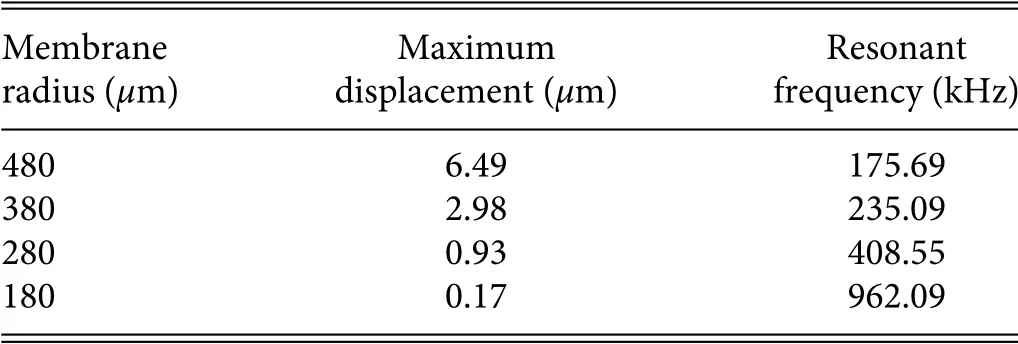
TABLE II.Simulation results for maximum static displacement and resonant frequency of CMUTs with different values of the membrane radius.
The finite element method (FEM) was adopted in this study to model and simulate the static and dynamic characteristics of the CMUT cell with the aim of determining its structural parameters.Considering the symmetry of the circular membrane,a 2D axisymmetric model of the CMUT was adopted and established in COMSOL software, as shown in Fig. 2. Since the vibrational process of the CMUT is essentially vibration of the peripherally fixed membrane, the silicon substrate could be ignored in the modeling, and a displacement constraint was applied to the bottom of the insulation layer. The material parameters of the various parts of the CMUT used in the FEM are shown in Table I,whereρis the density,Eis Young’s modulus,νis Poisson’s ratio,andεris the dielectric constant.The static displacement and resonant frequency of the CMUT could then be obtained by static and modal analysis using the FEM.
The attenuation of ultrasound pressure in air is directly proportional to the propagation distance and the square of the frequency.20Hence,the resonant frequency of the air-coupled CMUT in this study was designed not to exceed 400 kHz, to reduce attenuation. Limited by the device layer thickness of the siliconon-insulator (SOI) wafers available for CMUT fabrication in our laboratory, the thickness of the CMUT membrane was fixed as 10μm.
The cavity of the CMUT can be vacuum or filled with gas. In this study, a vacuum cavity was chosen for the air-coupled application because it eliminated the squeeze film damping effect of the cavity and hence reduced the energy loss of the CMUT membrane.21With a vacuum cavity, the CMUT membrane will undergo static displacement under atmosphere pressure, and so the maximum static displacement and resonant frequency of CMUTs with different radii were simulated,as shown in Table II.A membrane radius of 480μm was chosen, since the resulting relatively low frequency increased the propagation distance of ultrasound in air.Considering that the static displacement was simulated as 6.49μm with the radius of 480μm,a cavity depth of 10μm was set to ensure sufficient space for vibration. A certain thickness of insulation layer between the substrate and the vibrating membrane is required to prevent shortcircuiting in the case of membrane collapse and to avoid electric breakdown of the cavity when a high DC voltage is applied. However, the effective electric field strength and coupling efficiency of the CMUT will be reduced if the thickness of the insulation layer is too large.Taking account of the collapse voltage of the designed CMUT (517 V), the thickness of the insulation layer was set as 2.2μm.
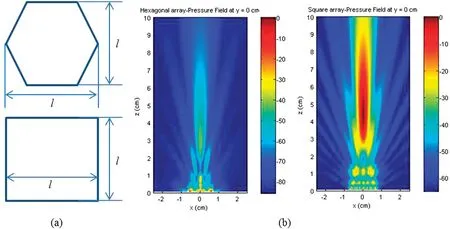
FIG.3.(a)Dimensions of hexagonal and square arrays.(b)Emitted ultrasound fields of hexagonal and square arrays.
B. Design of CMUT array
The directivity of the transmitted ultrasound beam is key to the applications of parametric arrays,22and therefore it is necessary to simulate the ultrasound beam transmitted by a CMUT array. Field II, written by Jensen,23is a MATLAB simulation program for ultrasound systems and can simulate the sound field of an ultrasonic transducer using the spatial impulse response method.It can also simulate ultrasonic transducers with arbitrary geometry.Hence,Field II was selected here to simulate the ultrasound field of the CMUT array. In this study, two kinds of CMUT arrays were considered: a hexagonal array and a traditional square array. The side length of the square array and the length between two vertices of the hexagonal array were identical, as shown in Fig. 3(a).Fifteen cells were distributed along the lengthl; obviously, the number of cells in the square array was greater than that in the hexagonal array. In both arrays, the radius of the cells was set as 480μm, the frequency was 175 kHz, and the cell spacing was 140μm.
The ultrasound fields of the hexagonal and square arrays were obtained, as shown in Fig. 3(b). It can be seen that, compared with the hexagonal array, the square CMUT array has a stronger ultrasonic field,a more distant focal point,and a greater beam width.To improve the directivity of the CMUT array,the hexagonal array design was selected for further study.

FIG.4.Structure of hexagonal CMUT array.
To investigate the impedance characteristics of different CMUT elements for our subsequent study of circuits, the hexagonal array in Fig. 3(a) was divided into two elements (an inner and a middle element)by a trench,and an outermost hexagonal CMUT element was also designed,as shown in Fig.4.The trench between the inner and middle elements has little effect on the directivity of the hexagonal array, since the side length of the array does not change.Each element is a subarray,and different subarrays can be combined to work together.To ensure the reliability of the gold wire connection,two gold electrode pads were led out from each subarray. In addition, single test cells were designed at the periphery of the array,as shown in Fig.4.
III. FABRICATION AND CHARACTERIZATION OF CMUT
A. Fabrication and packaging of CMUT
In this study,the CMUT array was fabricated by an SOI wafer bonding process. Compared with the sacrificial release process,wafer bonding not only allows better dimensional and stress control,but also provides high consistency and high yield when processing low-frequency CMUTs with large membranes and deep cavities.24As shown in Fig. 5, the fabrication process can be summarized as follows. First, the doped silicon wafer was thermally oxidized to a predetermined thickness.After that,the cavity shape of the cell was defined on the oxide layer by photolithography,and the cavity was then dry-etched and another layer of silicon oxide was grown.The silicon substrate with cavities was bonded with the SOI wafer under vacuum condition. The back substrate and buried oxide layer of the SOI were removed, and the monocrystalline silicon layer was released to act as the membrane of the CMUT. Next, an opening was defined and etched onto the doped silicon substrate to establish the connection with the bottom electrode.To separate different subarrays,an isolation channel was etched onto the insulation layer.Finally, gold was sputtered and patterned on the top and bottom electrodes of the CMUT.
Owing to the small size of the gold electrode pads on the fabricated bare CMUT chip, it was not convenient to directly weld wires for performance tests or for making connections with the CMUT driving or receiving circuits. Therefore, a printed circuit board (PCB) with gold pads was designed. First, the bare CMUT chip was pasted and fixed to the device area of the PCB,and then the gold electrode pads of the CMUT were connected to the gold pads on the circuit board through gold wires.The subsequent design of driving or receiving circuits could be carried out directly on the PCB.In addition,the PCB could also support and protect the bare CMUT chip.The packaged device is shown in Fig.6(a).Figures 6(b)and 6(c)show scanning electron microscope(SEM)images of selected parts of the hexagonal CMUT array.
B. Performance characterization of CMUT

FIG.5.Fabrication process of the CMUT array.
To accurately observe the deformation of the CMUT membrane,the packaged CMUT device was tested using a high-precision,noncontact 3D optical profilometer(S neox,Sensofar,Spain).Owing to the large radius of the membrane, a 20× lens was used, and the measurement results are shown in Fig. 7. The figure shows the 3D morphology of the CMUT,and it can be observed that the center of the CMUT membrane undergoes the maximum displacement. To measure the deformation of the membrane,a line passing through its center point was selected, and the static displacement values of each point on this line were obtained,as shown in Fig.7.It can be seen that the FEM simulation result (6.49 μm) is very close to the experimental result(6.45 μm),proving that the FEM could predict the deformation of the CMUT membrane accurately.The deviation can be attributed to the fact that the actual structural and material parameters of the CMUT membrane would have been slightly different from those of the FEM despite the strict dimensional control achieved by the wafer bonding technique Moreover, the deviation can also attributes to the residual stress that inevitably introduced into the membrane during the fabrication.
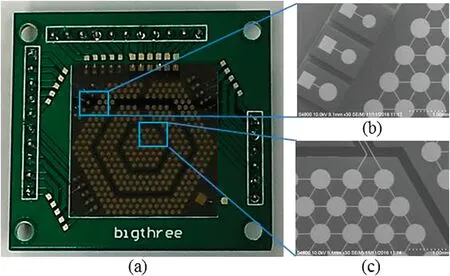
FIG. 6. (a) Photograph of packaged hexagonal CMUT array.(b)and(c)SEM images of the areas of the array outlined in blue in(a).

FIG.7.Measured static displacement of CMUT membrane.
An Agilent 4294A impedance analyzer was used to obtain impedance curves of the CMUT in air, which facilitated characterization of the impedance characteristics, resonant frequency,and quality factor of the CMUT. The 4294A analyzer has a wide measurement frequency range (40-110 MHz) and high measurement accuracy (±0.08%). An Agilent 16065a impedance analyzer fixture, providing a DC voltage up to 200 V for the CMUT, was used together with the analyzer.DC voltages of 40 V and 150 V,as well as an AC voltage of 0.5 V, were applied to the top and bottom electrodes, respectively, of the hexagonal CMUT array, and Z-θ curves of the inner element, inner + middle element, and all three elements of the hexagonal array were obtained, as shown in Fig.8.
From Fig. 8, it can be seen that at the higher DC voltage(150 V),the amplitudes of the changes in θ are greater,but the maximum values of θ are still negative,which indicates that the capacitance characteristic of the CMUT plays a major role.The Z curves exhibit a decreasing trend, indicating that the capacitive reactance decreases with increasing frequency. In addition, the impedance value changes suddenly at a certain frequency.The frequencies corresponding to the minimum and maximum impedances near this location are the series and parallel resonant frequencies,respectively,of the CMUT array. The sudden change in Z is much more obvious at the higher DC voltage (150 V). With increasing number of CMUT elements, the resonant frequencies at 40 V are 183.72 kHz,181.15 kHz,and 180.80 kHz.At 150 V,the resonant frequencies are 180.01 kHz,178.00 kHz,and 179.40 kHz.The measured values were a little higher than the simulated results, which was again due to the inevitable residual stress arising during fabrication and the slight difference between the actual and FEM parameters of the CMUT membrane.
The following conclusions can be drawn from the curves in Fig.8:
1. The resonant frequencies of different elements of the CMUT are slightly different, which indicates that there exist differences between these elements. In general, the consistency of the fabricated CMUT is good.
2. The resonant frequency of the CMUT decreases as the DC voltage increases from 40 V to 150 V for each combination of elements, which indicates that the spring softening effect of the DC voltage reduces the resonant frequency of the CMUT.
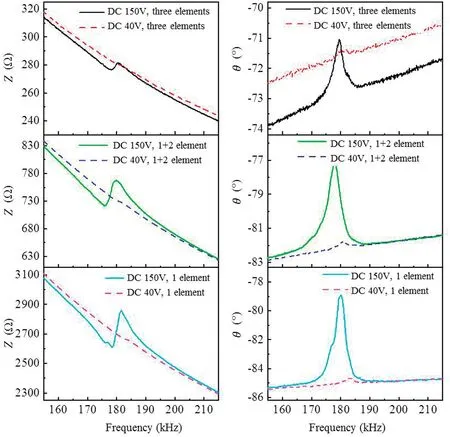
FIG. 8. Electrical impedance curves for the inner element (“element 1”), inner+ middle element (“elements 1 + 2”),and all three elements of the hexagonal CMUT array under DC voltages of 40 V and 150 V.
3. The electrical impedance decreases as the number of CMUT elements increases. Therefore, the impedance of the CMUT array can be adjusted to match that of the external circuit by altering the number of CMUT cells.
4. The maximum amplitude of theθcurve reflects the vibrational amplitude of the CMUT membrane,which increases when the DC voltage is increased.
5. The amplitude of the inner element is close to that of the inner+ middle elements, but the amplitude of the three elements together decreases, which indicates that the performance with all three elements together deteriorates mainly owing to the difference in performance between the outer and inner+middle elements.Therefore,the inner+middle element was mainly used to radiate ultrasound into air in the subsequent experiments.
IV. CIRCUIT OPTIMIZATION AND EXPERIMENTS
When the CMUT array is used as a transmitter, both the DC and AC voltages must be applied to the top and bottom electrodes of the CMUT to realize ultrasound emission. The DC voltage was provided by a DC power supply (Agilent N5771A), and the AC voltage was provided by a signal generator (Tektronix AFG 3152C) and amplified by a voltage amplifier (TEGAM 2350).However,the DC voltage and the AC voltage could not be coupled directly.
A. Bias-T circuit optimization
The coupling circuit of the DC and AC voltages, also called a bias-T circuit, is shown in Fig. 9. A DC voltageUDCand an AC voltageUACare applied to the electrodes of the CMUT after passing through a resistanceRand a capacitanceC,respectively.A large resistor is used to limit the current of the circuit,which also reduces the influence of the AC source on the DC source. The capacitor is used to block the DC voltage and thus eliminate its influence on the AC source.In Fig. 9,U0is the actual voltage exerted on the electrodes of the CMUT, andZ=R0+ jC0(where j =) is the equivalent impedance of the CMUT,which can be obtained from Fig.8.Ideally,U0is the sum ofUDCandUAC.However,the DC and AC voltages cannot be effectively exerted on both ends of the electrodes if the values ofRandCare not appropriate. Therefore, to improve the emission efficiency of the CMUT, the optimization of bias-T circuit was to select the appropriate values ofRandCto ensure thatU0=UDC+UAC.
According to the superposition principle, when only a DC voltage is applied,U0=UDC,sinceZis much larger thanR.
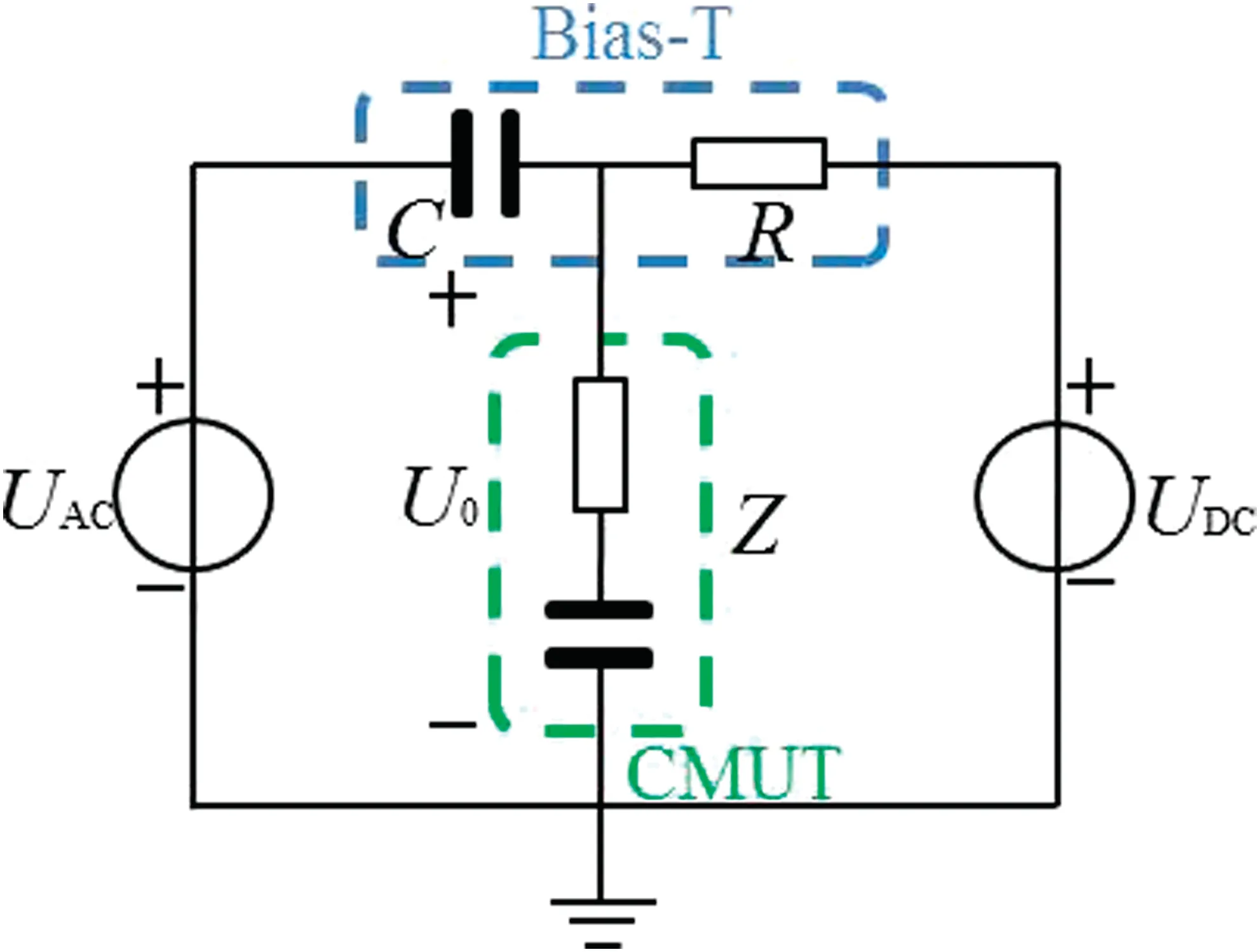
FIG.9.Diagram of bias-T circuit for CMUT.
When only an AC voltage is applied,U0can be expressed as follows:

whereω=2πfandfis the frequency.To makeU0=UAC,we must decreaseRand increaseC.The maximum safe current in the circuit is 8 mA, and soRis chosen to be 120 kΩ. Calculation shows thatU0≈UACcan be guaranteed ifCis greater than 10 nF.The higher the value ofC, the closer areU0andUAC. Here,Cis chosen to be 10 nF.Care should be taken thatCis a high-voltage capacitor that can withstand voltages above 1000 V.
B. Experiments on parametric array and discussion of results

FIG. 11. Waveforms acquired for different modulated signals transmitted by the CMUT.
The optimized parameters of the bias-T circuit were used to excite the hexagonal CMUT array to emit ultrasound. The parametric array system was composed principally of an ultrasonic transmitting circuit, a parametric array to transmit the modulated ultrasound signal,an acoustic receiver to receive the low-frequency acoustic signal,a receiving circuit,and an oscilloscope to collect and display the received signal,as shown in Fig.10.The CMUT array was used as the parametric array in this study, and a microphone was used as the acoustic receiver. To simplify the circuit, a modulated signal was generated by the signal source and then amplified by the voltage amplifier.After coupling with the DC source,the superimposed signal was applied to the CMUT array for transmission.Based on Berktay’s far-field solution theory, the frequencies of the audio and carrier signal are assumed to bef0andfG,respectively.Therefore, the modulated signal has frequency contentf0,fG,fG+f0,fG?f0.Sincef0?fGand high-frequency waves decay rapidly in air,the highly directional audio signalf0is self-demodulated along the highly directional beam owing to the nonlinear effect of the air.22

FIG. 10. Experimental system for parametric array.

FIG. 12. Frequency-domain analysis of the acquired waveforms.
In the experiments, the DC voltage was 100 V, and the signal generator was used to generate a modulated signal (the carrier signal was 180 kHz with an amplitude of 2 VPP, and the modulation signal frequency was 20 kHz). After amplified by the voltage amplifier (TEGAM 2350), the modulated signal was applied to the 180 kHz CMUT array, and the modulated wave was then radiated into air. During propagation, the modulation signal was selfdemodulated through the nonlinear effect of the air. The sound was received by the microphone and collected by the oscilloscope.Figure 11 shows the waveforms acquired when changing the frequency of the modulated signal to 20 kHz, 15 kHz, 10 kHz, and 5 kHz sequentially. The envelope of each waveform was the lowfrequency modulation signal, which was obtained by frequencydomain analysis with MATLAB,as shown in Fig.12.It can be seen that the peak signal corresponds very well to the frequency of the modulation signal.During the experiments,when the difference frequency signal was lower than 20 kHz,clearly audible sound could be heard in the range of 1-2 m in front of the transmitting array.
Signal processing is critical in the design of ultrasonic transmitting circuits for parametric arrays.In our preliminary exploration of the application of CMUTs in air parametric arrays,the design and feasibility of a CMUT as an air-coupled parametric array have been verified, but optimization of signal processing has yet to be done.Our next work will focus on the design of driving and receiving circuits to improve the performance of parametric array systems based on CMUT arrays.
V. CONCLUSIONS
In this study, an air-coupled hexagonal CMUT array was designed and fabricated for air parametric array application.The structural parameters of the CMUT cell were determined using an FEM model.The CMUT was fabricated by a wafer bonding process. Its performance was then tested, and the results were found to be in good agreement with those from the FEM simulation results. After the parameters of the bias-T circuit had been optimized, air parametric array experiments were carried out with the CMUT array,and preliminary detection of low-frequency acoustic signals was realized.This study provides an important reference for the design of air-coupled CMUTs and for their applications in air-coupled parametric arrays.
ACKNOWLEDGMENTS
This work was supported by the National Key R&D Program of China (Nos. 2017YFA0205103 and 2018YFE020505), the National Natural Science Foundation of China(Nos.81571766 and 61771337), the Natural Science Foundation of Tianjin, China (No.17JCYBJC24400),and the“111”Project of China(No.B07014).
The authors declare no conflicts of interest.
- 納米技術(shù)與精密工程的其它文章
- Propagation characteristics of photonic crystal fibers selectively filled with ionic liquid
- Deep-learning-based nanowire detection in AFM images for automated nanomanipulation
- A combined virtual impactor and field-effect transistor microsystem for particulate matter separation and detection
- On-site low-power sensing nodes for distributed monitoring of heavy metal ions in water
- Characteristics of Ni-based ohmic contacts on n-type 4H-SiC using different annealing methods

